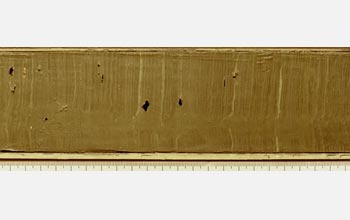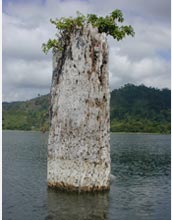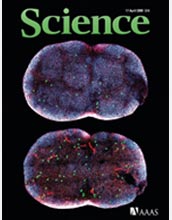All Images


Press Release 09-066
West African Droughts are the Norm, not an Anomaly

Some droughts lasted centuries in the past, and a warming planet may make future droughts more devastating
Back to article | Note about images
 |
Large, often barren, tropical trees stand where they once grew when the area was in severe drought and water levels in Lake Bosumtwi in Ghana had bottomed out. Submerged in 15-20 meters of water, the trees are stark reminders of severe, long lasting dry spells from just a few centuries ago. In this photo, a partially submerged tree is surrounded by boys from nearby villages who still practice traditional fishing methods on the lake.
Credit: Photograph by J.T. Overpeck and W. Wheeler, University of Arizona. |
Download the high-resolution JPG version of the image. (824 KB)
|
Use your mouse to right-click (Mac users may need to Ctrl-click) the link above and choose the option that will save the file or target to your computer.
|
 |
 Play Audio Play Audio
Timothy Shanahan of the University of Texas at Austin, Jonathan Overpeck of the University of Arizona and Paul Filmer of NSF discuss the findings of the recent Science paper "Atlantic forcing of persistent drought in West Africa" in a call with reporters on Apr. 15, 2009.
Credit: National Science Foundation
|
 |
Photograph of a sediment core taken from Lake Bosumtwi, Ghana, displaying annually deposited layers. These layers provide a high-resolution chronology for the sediments and a means of reconstructing past climate variations.
Credit: Photograph by T.M. Shanahan, J.T. Overpeck, University of Arizona. |
Download the high-resolution JPG version of the image. (458 KB)
|
Use your mouse to right-click (Mac users may need to Ctrl-click) the link above and choose the option that will save the file or target to your computer.
|
 |
Life emerges from an old tree stump growing out of the ancient lake bed at Lake Bosumtwi, Ghana. Now inundated with water, during the severe droughts of the last three millennia, the lake bed once hosted trees and other arid environment vegetation.
Credit: Photograph by T.M. Shanahan, University of Arizona. |
Download the high-resolution JPG version of the image. (416 KB)
|
Use your mouse to right-click (Mac users may need to Ctrl-click) the link above and choose the option that will save the file or target to your computer.
|
 |
The research findings appear in the Friday, April 17, 2009 issue of Science magazine.
Credit: Copyright AAAS, 2009 |
Download the high-resolution JPG version of the image. (41 KB)
|
Use your mouse to right-click (Mac users may need to Ctrl-click) the link above and choose the option that will save the file or target to your computer.
|
|







